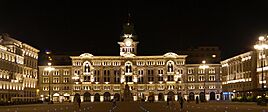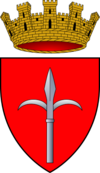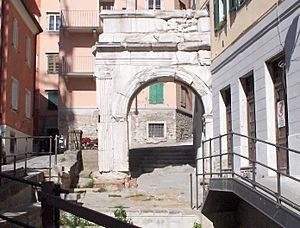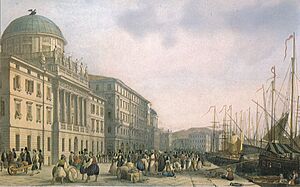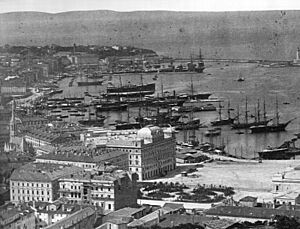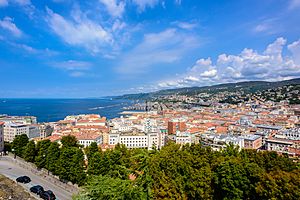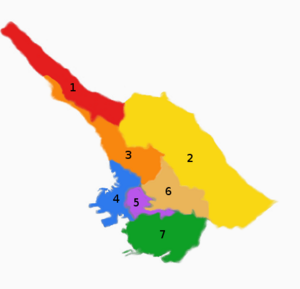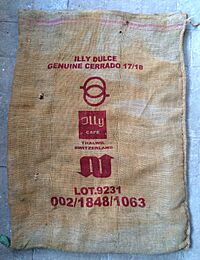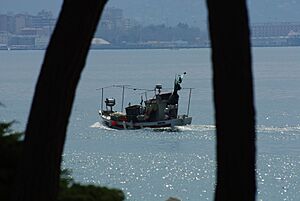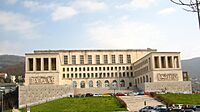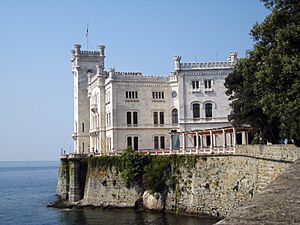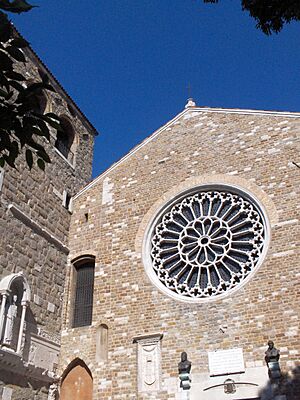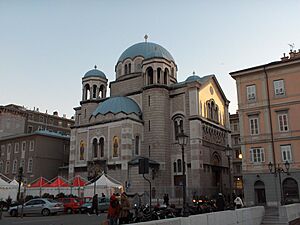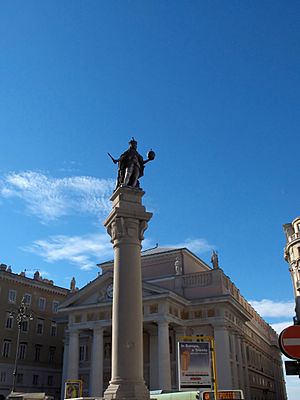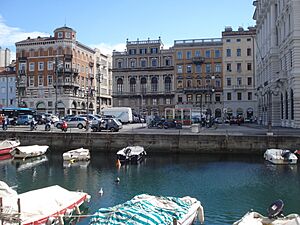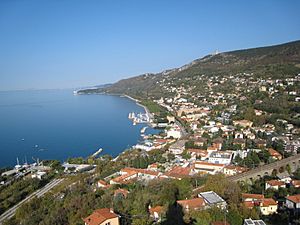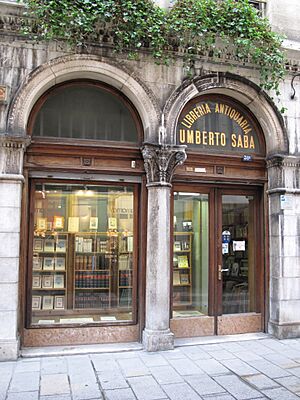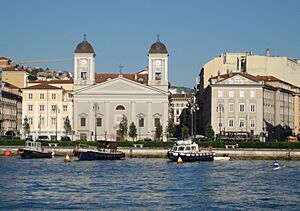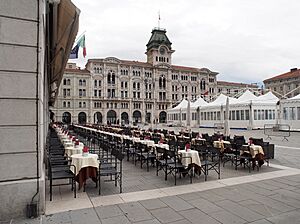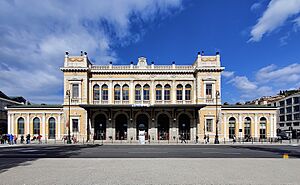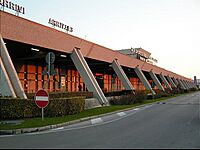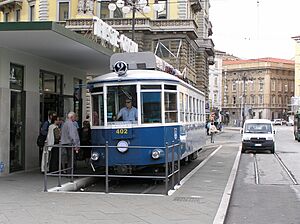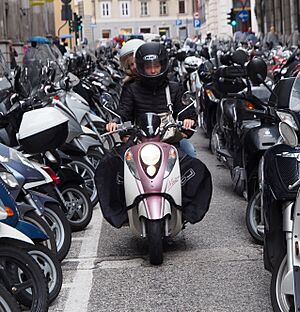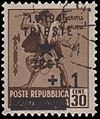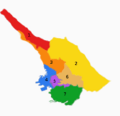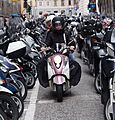Trieste facts for kids
Quick facts for kids
Trieste
Trst (Slovene)
|
|||
|---|---|---|---|
| Comune di Trieste | |||
|
Piazza Unità d'Italia
Canal Grande with Sant'Antonio Taumaturgo Church
Saint Spyridon Church
Arco di Riccardo
Miramare Castle
view of Trieste from Molo Audace
|
|||
|
|||
| Country | Italy | ||
| Region | Friuli-Venezia Giulia | ||
| Province | Trieste | ||
| Frazioni | Banne (Bani), Barcola (Barkovlje), Basovizza (Bazovica), Borgo San Nazario, Cattinara (Katinara), Conconello (Ferlugi), Contovello (Kontovel), Grignano (Grljan), Gropada (Gropada), Longera (Lonjer), Miramare (Miramar), Opicina (Opčine), Padriciano (Padriče), Prosecco (Prosek), Santa Croce (Križ), Servola (Škedenj), Trebiciano (Trebče) | ||
| Area | |||
| • Total | 84.49 km2 (32.62 sq mi) | ||
| Elevation | 2 m (7 ft) | ||
| Population
(2018)
|
|||
| • Total | 204,338 (Comune) 234,638 (Urban) 418,000 (Metro) |
||
| Demonym(s) | English: Triestine or Triestino Italian: triestino (m.), triestina (f.) |
||
| Time zone | UTC+1 (CET) | ||
| • Summer (DST) | UTC+2 (CEST) | ||
| Postal code |
34100
|
||
| Dialing code | 040 | ||
| Patron saint | St. Justus of Trieste | ||
| Saint day | 3 November | ||
Trieste is a city and port in northeastern Italy. It is the capital of the Friuli-Venezia Giulia region. Trieste is located at the top of the Gulf of Trieste, between the Adriatic Sea and Slovenia. Slovenia is very close, about 8 kilometers (5 miles) east of the city.
The city has a long coastline. It is surrounded by grasslands, forests, and karst areas. In 2022, about 204,302 people lived there.
Trieste was part of the Habsburg monarchy from 1382 to 1918. In the 1800s, it was the most important seaport for this powerful empire. Trieste became a busy trading center in the Mediterranean. It grew to be the fourth-largest city in the Austro-Hungarian Empire. Around 1900, it became a key place for literature and music.
Trieste's economy improved in the 1930s. After World War II, the Free Territory of Trieste became a major point of interest. It was a place where the Eastern Bloc and Western Bloc had disagreements.
Today, Trieste is a deep-water port. It is a gateway for goods going to northern Italy, Germany, Austria, and Central Europe. It is also seen as the end point of the maritime Silk Road. This route connects to the Suez Canal and Turkey. Since the 1960s, Trieste has become a top research location in Europe. This is because it has many international groups and schools.
The city is a meeting point of Latin, Slavic, and Germanic cultures. It is where Central Europe meets the Mediterranean Sea. Trieste is home to many different groups of people and religions. It has the highest number of researchers per person in Europe. People call Trieste "City of the Barcolana" (a famous sailing race). They also call it "City of the bora" (a strong wind). Other nicknames include "City of Wind," "Vienna by the sea," and "City of Coffee."
Contents
- Understanding Trieste's Name
- Trieste's Journey Through Time
- Trieste's Location and Weather
- Trieste's City Layout
- Trieste's Economy
- Learning and Discovery in Trieste
- Trieste's Population Story
- Languages Spoken in Trieste
- Must-See Sights in Trieste
- Trieste's Culture and Arts
- Triestine Food
- Getting Around Trieste
- Trieste's Global Connections
- Images for kids
- See also
Understanding Trieste's Name
The name Trieste likely comes from an old Celtic word, Tergeste. This word might be linked to an ancient word meaning "market." Roman writers also used the name Tergestum. They thought it came from "TER GESTUM [BELLUM]," meaning "three battles." This was because the Roman Army fought three battles with local tribes.
Today, the city is called Trieste in Italian. Other names include Trst in Slovene and Triest in German.
Trieste's Journey Through Time
Historical affiliations
Roman Empire, pre 395
Western Roman Empire, 395–476
Byzantine Empire, 476–567
Lombards, 567−788
Francia, 788−843
Middle Francia, 843−855
Patriarchate of Aquileia, 855–952
March of Verona, 952–1081
![]() Patria del Friuli, 1081–1368
Patria del Friuli, 1081–1368
![]() Republic of Venice, 1368–1369
Republic of Venice, 1368–1369
Patriarchate of Aquileia, 1378–1382
![]() Holy Roman Empire, 1382−1806
Holy Roman Empire, 1382−1806
![]() Austrian Empire, 1804–1809
Austrian Empire, 1804–1809
![]() First French Empire, 1809–1814
First French Empire, 1809–1814
![]() Austrian Empire, 1814–1867
Austrian Empire, 1814–1867
![]() Austria-Hungary, 1867−1922
Austria-Hungary, 1867−1922
![]() Kingdom of Italy, 1922–1943
Kingdom of Italy, 1922–1943
![]() OZAK, 1943–1945
OZAK, 1943–1945
![]() Allied Military Government, 1945–1947
Allied Military Government, 1945–1947
![]() Free Territory of Trieste, 1947–1954
Free Territory of Trieste, 1947–1954
![]() Italy, 1954–present
Italy, 1954–present
Ancient Times
People have lived in the Trieste area since 2000 BC. The Veneti people arrived around 1000–900 BC. They likely gave the town its name, Tergeste, meaning "market." Later, the Carni tribe took over.
Trieste became part of the Roman republic in 177 BC. After some attacks, Julius Caesar made it a Roman colony in 46 BC. He wrote about it as Tergeste in his book.
During the Roman Empire, Trieste grew because it was a port city. It was on the road from Aquileia, a major Roman city. Emperor Augustus built walls around the city in 33–32 BC. Trajan built a theater in the 2nd century. Some Roman ruins are still visible today.
In early Christian times, Trieste continued to do well. The area around Barcola was a fishing village. Rich Roman villas with gardens were found there. This shows it was a relaxing place for Romans. They even grew grapes for a special wine called "Vinum Pucinum."
Middle Ages
In 788, Trieste came under the rule of Charlemagne. It was then controlled by a bishop. In the 1200s and 1300s, Trieste competed with Venice for sea trade. Venice briefly took over Trieste from 1283 to 1287.
In 1368, Venice declared war on Trieste and occupied it. But Venice was forced to leave in 1372. In 1382, Trieste asked Leopold III of Habsburg to add it to his lands. This agreement was signed on September 30, 1382.
Trieste kept some freedom under the Habsburgs. But it lost trade to Venice and Ragusa. In 1463, Venice tried to attack Trieste again. Pope Pius II helped save the city. However, Venice limited Trieste's territory. In 1468–1469, Emperor Frederick III attacked and damaged the city. He later rebuilt its walls.
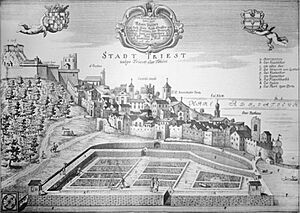
Early Modern Period
In 1508, Venice occupied Trieste again. But the Habsburg monarchy got it back a year later. By the 1700s, Trieste became an important port for the Austrians. In 1719, Emperor Charles VI made it a free port. This meant goods could enter and leave without taxes.
The rule of Maria Theresa of Austria brought a very good time for the city. Many Serbs moved to Trieste in the 1700s and 1800s. They became a rich and powerful group. Many Serbian traders owned important businesses and built grand buildings.
The 1800s
Trieste was briefly taken over by French troops during the Napoleonic Wars. This happened in 1797, 1805, and 1809. From 1809 to 1813, Trieste was part of the Illyrian Provinces. It lost its free port status and freedom.
After the wars, Trieste returned to the Austrian Empire in 1813. It continued to grow as the Free Imperial City of Trieste. This status gave it economic freedom. The city's role as Austria's main trading port grew. The Austrian Lloyd shipping company started in 1836. By 1913, it had 62 ships.
When Austria got a new constitution in 1860, Trieste regained its local freedom. It became the capital of the Austrian Littoral region. Trieste also became an important base for the Imperial and Royal Navy. The first major railway in the Empire, the Austrian Southern Railway, reached Trieste in 1857. This helped with coal trade.
Some people in Trieste wanted to join Italy. This feeling was called irredentism. In 1882, a man named Wilhem Oberdank tried to harm Emperor Franz Joseph. The Emperor was visiting the city. Oberdank was arrested and sentenced to death. He became a hero to those who wanted to join Italy. The Emperor never visited Trieste again.
The 1900s
At the start of the 1900s, Trieste was a busy, diverse city. Artists and thinkers like James Joyce and Sigmund Freud visited. It was the main port on the Austrian Riviera.
World War I and Joining Italy
Italy joined World War I with the Allied Powers. In return, Italy was promised new lands, including Trieste. So, Italy took over Trieste after the war. This was agreed in the 1915 Treaty of London.
In the late 1920s, there were tensions in the city. Italian fascists burned down a Slovene cultural center. A Slovene group called TIGR carried out some bomb attacks. During the 1920s and 1930s, many grand buildings were built. These included the University of Trieste and the tall Victory Lighthouse. The economy improved in the late 1930s.
World War II and Aftermath
After Italy's surrender in 1943, German troops occupied Trieste. It was part of a German-controlled area. The only concentration camp in Italy with a crematorium was built near Trieste. It was called Risiera di San Sabba. Many people were held, questioned, and sadly, some were killed there.
The city also saw fighting from Italian and Yugoslav resistance groups. It was bombed by Allied planes. These bombings targeted oil refineries and the port. They caused damage and deaths in the city.
On April 30, 1945, local anti-Fascist groups started a revolt. On May 1, Yugoslav Partisans took control of most of the city. British and American forces arrived the next day. The German forces surrendered to them.
The Yugoslavs controlled the city until June 12. During this time, many local Italians and Slovenes were arrested. Some were sent to camps, and others disappeared. British Field Marshal Harold Alexander criticized the Yugoslav occupation.
Trieste in Limbo
After an agreement, Yugoslav forces left Trieste. The city came under British-U.S. military rule. In September 1947, the Paris Peace Treaty created the Free Territory of Trieste. This territory was divided into two zones, A and B.
From 1947 to 1954, Zone A was governed by the Allied Military Government. This included American and British forces. Zone B was controlled by Yugoslavia.
In 1954, most of Zone A, including Trieste city, joined Italy. Zone B and four villages from Zone A became part of Yugoslavia. The final border with Yugoslavia was set in 1975. This line is now the border between Italy and Slovenia.
Trieste's Location and Weather
Geography of Trieste
Trieste is in the northernmost part of the Adriatic Sea. It is in northeastern Italy, close to Slovenia. The city sits on the Gulf of Trieste. It is built mostly on a hillside. The city's land rises sharply from the sea to the Karst Plateau. The Karst hills reach about 458 meters (1,503 feet) above sea level. Trieste is where the Italian, Balkan, and Central European regions meet.
Trieste's Climate
Trieste has a humid subtropical climate. Winters are cool, and summers are hot. The air is usually not very humid. Only three months (January, March, and July) get slightly less than 60 mm (2.4 inches) of rain.
Trieste gets over 900 mm (35 inches) of rain each year. There is no real dry season in summer. Snow falls about 2 days a year.
Winter temperatures are lower than in other Mediterranean areas. Two main weather patterns happen. One is sunny, windy, and often cold days. These are caused by a northeastern wind called the bora. The other is rainy days with temperatures around 6 to 11 degrees Celsius (43 to 52 degrees Fahrenheit).
Summer is very warm. Highs are about 29 degrees Celsius (84 degrees Fahrenheit). Lows are above 20 degrees Celsius (68 degrees Fahrenheit). Warm sea water makes the nights hot. The highest temperature in the last 30 years was 40.1 degrees Celsius (104.2 degrees Fahrenheit) in 2020. The lowest was -7.9 degrees Celsius (17.8 degrees Fahrenheit) in 1996.
The bora wind can strongly affect the climate. It is a very dry and cool wind from the north or northeast. It can last for days and reach speeds of up to 140 km/h (87 mph) at the port. This can make temperatures drop below freezing.
| Climate data for Trieste (1991-2020 normals and extremes) | |||||||||||||
|---|---|---|---|---|---|---|---|---|---|---|---|---|---|
| Month | Jan | Feb | Mar | Apr | May | Jun | Jul | Aug | Sep | Oct | Nov | Dec | Year |
| Record high °C (°F) | 18.2 (64.8) |
18.2 (64.8) |
23.8 (74.8) |
29.8 (85.6) |
32.2 (90.0) |
36.8 (98.2) |
37.4 (99.3) |
38.0 (100.4) |
33.8 (92.8) |
30.8 (87.4) |
24.4 (75.9) |
18.4 (65.1) |
38.0 (100.4) |
| Mean daily maximum °C (°F) | 9.0 (48.2) |
9.7 (49.5) |
13.5 (56.3) |
17.7 (63.9) |
22.3 (72.1) |
26.5 (79.7) |
29.1 (84.4) |
29.1 (84.4) |
24.3 (75.7) |
19.1 (66.4) |
14.3 (57.7) |
10.2 (50.4) |
18.7 (65.7) |
| Daily mean °C (°F) | 6.3 (43.3) |
6.7 (44.1) |
10.0 (50.0) |
14.0 (57.2) |
18.5 (65.3) |
22.6 (72.7) |
25.0 (77.0) |
25.0 (77.0) |
20.5 (68.9) |
15.9 (60.6) |
11.5 (52.7) |
7.5 (45.5) |
15.3 (59.5) |
| Mean daily minimum °C (°F) | 4.2 (39.6) |
4.2 (39.6) |
7.1 (44.8) |
10.6 (51.1) |
14.9 (58.8) |
18.9 (66.0) |
21.0 (69.8) |
21.2 (70.2) |
17.2 (63.0) |
13.2 (55.8) |
9.2 (48.6) |
5.3 (41.5) |
12.3 (54.1) |
| Record low °C (°F) | −6.8 (19.8) |
−7.2 (19.0) |
−6.4 (20.5) |
1.2 (34.2) |
0.0 (32.0) |
8.4 (47.1) |
10.0 (50.0) |
11.0 (51.8) |
9.2 (48.6) |
0.0 (32.0) |
−1.3 (29.7) |
−7.3 (18.9) |
−7.3 (18.9) |
| Average precipitation mm (inches) | 51.5 (2.03) |
64.7 (2.55) |
56.6 (2.23) |
69.4 (2.73) |
80.9 (3.19) |
74.9 (2.95) |
55.6 (2.19) |
74.9 (2.95) |
108.3 (4.26) |
113.3 (4.46) |
117.5 (4.63) |
82.5 (3.25) |
950.1 (37.42) |
| Average snowfall cm (inches) | 1.0 (0.4) |
1.4 (0.6) |
0.6 (0.2) |
0.0 (0.0) |
0.0 (0.0) |
0.0 (0.0) |
0.0 (0.0) |
0.0 (0.0) |
0.0 (0.0) |
0.0 (0.0) |
0.0 (0.0) |
0.9 (0.4) |
3.9 (1.6) |
| Average precipitation days (≥ 1.0 mm) | 6.33 | 6.41 | 6.03 | 8.34 | 8.50 | 7.63 | 5.80 | 6.55 | 7.79 | 8.97 | 10.46 | 7.69 | 90.5 |
| Average snowy days | 1.2 | 1.0 | 0.6 | 0 | 0 | 0 | 0 | 0 | 0 | 0 | 0 | 0.7 | 3.5 |
| Average relative humidity (%) | 67.54 | 65.35 | 63.31 | 63.82 | 64.70 | 64.76 | 62.19 | 62.98 | 64.60 | 68.51 | 69.75 | 66.96 | 65.37 |
| Average dew point °C (°F) | 0.3 (32.5) |
0.1 (32.2) |
2.7 (36.9) |
6.7 (44.1) |
11.3 (52.3) |
15.2 (59.4) |
16.8 (62.2) |
16.9 (62.4) |
13.1 (55.6) |
9.7 (49.5) |
6.0 (42.8) |
1.3 (34.3) |
8.3 (47.0) |
| Mean monthly sunshine hours | 102.3 | 124.7 | 155.4 | 177.0 | 231.6 | 250.1 | 297.9 | 272.3 | 200.9 | 148.0 | 97.9 | 90.3 | 2,148.4 |
| Average ultraviolet index | 2 | 3 | 5 | 6 | 8 | 9 | 9 | 8 | 7 | 5 | 3 | 2 | 6 |
| Source 1: NOAA(Sun 1981-2010) | |||||||||||||
| Source 2: Weather Atlas(snow), Nomadseason(UV) | |||||||||||||
Trieste's City Layout
Trieste is divided into seven main areas. These areas are then split into smaller parts called frazioni.
- Altipiano Ovest: Includes Banne, Basovizza, Gropada, Opicina, Padriciano, and Trebiciano.
- Altipiano Est: Includes Contovello, Prosecco, and Santa Croce.
- Barcola, Cologna, Conconello, Gretta, Grignano, Guardiella, Miramare, Roiano, and Scorcola.
- Barriera Nuova, Borgo Giuseppino, Borgo Teresiano, Città Nuova, Città Vecchia, San Vito, San Giusto, Campi Elisi, Sant'Andrea, and Cavana.
- Barriera Vecchia, San Giacomo, and Santa Maria Maddalena Superiore.
- Cattinara, Chiadino, San Luigi, Guardiella, Longera, San Giovanni, Rozzol, and Melara.
- Chiarbola, Coloncovez, Santa Maria Maddalena Inferiore, Raute, Santa Maria Maddalena Superiore, Servola, Poggi Paese, Poggi Sant'Anna, Valmaura, Altura, and Borgo San Sergio.
The main city center is Piazza Unità d'Italia. It is located between the large 19th-century streets of Borgo Teresiano and the old medieval city. The old city has many narrow streets.
Trieste's Economy
During the Austro-Hungarian era, Trieste was a leading city for trade and business in Europe. It was the fourth-largest and most important center in the empire. After Trieste joined Italy in 1922, its economy slowed down.
In the 1930s, the Fascist government started new projects. These focused on shipbuilding and making defense products. World War II bombings destroyed the city's industrial areas. However, since the 1970s, Trieste's economy has been growing steadily.
After the fall of the Iron Curtain, trade in Trieste increased. This was also due to more countries joining the EU. The Port of Trieste is a major trade hub in the northern Mediterranean. It has a lot of commercial shipping, containers, and oil terminals. The port is part of the Silk Road plan. This is because it can handle very large container ships.
The oil terminal is important for the Transalpine Pipeline. This pipeline provides 40% of Germany's energy. It also supplies 90% of Austria's and 50% of the Czech Republic's energy. The sea route connecting Trieste and Istanbul is one of the busiest for roll-on/roll-off ships. The port is also Italy's biggest coffee port. It supplies over 40% of Italy's coffee.
Trieste's coffee industry started under Austria-Hungary. The government even made the city tax-free to encourage more trade. Today, Trieste is known as "the coffee capital of Italy." Many coffee companies are based here. A large part of Italy's coffee imports are handled in Trieste.
Two big global companies, Assicurazioni Generali and Allianz, have offices in Trieste. Other companies include Fincantieri, a top shipbuilding company, and Wärtsilä. Many new companies are also starting in Trieste. The city is sometimes called Italy's Silicon Valley. Trieste has the most researchers per person in Europe. They enjoy the good quality of life and free time. People often say you can ski and swim in the sea on the same day from Trieste.
Commercial Fishing in Trieste
Fishing boats dock at Molo Veneziano. In summer, large lamps are used for fishing. In autumn and winter, smaller nets are used. Fishing in the Gulf of Trieste is hard because the water is very clear and has little plankton. The fishing season is from May to July. Fishing is not allowed in August to help fish reproduce.
As of 2009, there were fewer than 200 professional fishermen in the city. There is also a small fishing port in Barcola. Some fish are sold directly from boats. Others go to local shops and restaurants. The rare anchovies from the Gulf of Trieste are very popular. They are caught near Barcola during the Sirocco wind. They are known for their white meat and special taste.
Learning and Discovery in Trieste
Education and Research Centers
The University of Trieste opened in 1924. It is a state-supported school with 12 departments. It has about 23,000 students and 1,000 professors.
Trieste is also home to the Scuola Internazionale Superiore di Studi Avanzati (SISSA). This is a top school for math, theoretical physics, and neuroscience. The MIB School of Management Trieste is also here.
There are three international schools for kids and teens. These schools offer programs in English. They are the International School of Trieste, the European School of Trieste, and the United World College of the Adriatic. The last one is in the nearby village of Duino.
The city has many national and international science groups:
- AREA Science Park
- ELETTRA, a particle accelerator for research
- International Centre for Theoretical Physics, a UN-backed center
- Trieste Astronomical Observatory
- Istituto Nazionale di Oceanografia e Geofisica Sperimentale (OGS), for ocean and earth science
- International Centre for Genetic Engineering and Biotechnology, a UN center for developing countries
- ICS-UNIDO, a UNIDO research center for renewable energy and food safety
- Carso Center for Advanced Research in Space Optics
- The World Academy of Sciences (TWAS)
- InterAcademy Panel: The Global Network of Science Academies (IAP)
- International Union of Pure and Applied Physics (IUPAP)
- Istituto Nazionale di Fisica Nucleare (Italian National Institute for Nuclear Physics)
- Laboratorio di Biologia Marina (Marine Biology Lab)
- Laboratory TASC Technology and Nano Science
- Orto Botanico dell'Università di Trieste (University Botanical Garden)
- Civico Orto Botanico di Trieste (Civic Botanical Garden)
Trieste is also a center for company training. Generali has its Generali Academy here. Illy has its Università del Caffé. This coffee school started in 1999. It teaches about quality coffee and does research.
Because of all this research and business, many new companies are starting in Trieste. The city has the most start-ups in Italy. Neurala, an artificial intelligence company, chose Trieste for its European research center.
Trieste's Population Story
| Historical population | ||
|---|---|---|
| Year | Pop. | ±% |
| 1921 | 239,558 | — |
| 1931 | 250,170 | +4.4% |
| 1936 | 248,307 | −0.7% |
| 1951 | 272,522 | +9.8% |
| 1961 | 272,723 | +0.1% |
| 1971 | 271,879 | −0.3% |
| 1981 | 252,369 | −7.2% |
| 1991 | 231,100 | −8.4% |
| 2001 | 211,184 | −8.6% |
| 2011 | 202,123 | −4.3% |
| 2021 | 199,015 | −1.5% |
| Source: ISTAT | ||
| Trieste, FVG | Italy | |
|---|---|---|
| Median age | 49 years | 45.7 years |
| Under 18 years old | 13.25% | 16.6% |
| Over 65 years old | 28.3% | 23.5% |
| Foreign Population | 11.38% | 8.78% |
| Births/1,000 people | 6.0 b | 6.8 b |
As of 2020, Trieste had 200,609 people. About 48.1% were male and 51.9% were female. Trieste has lost about one-third of its population since the 1970s. This is due to a decline in industries like steel and shipbuilding. Also, fewer babies are being born, and the population is getting older.
Children aged 18 and younger make up 13.25% of the population. People over 65 make up 27.9%. The average age of people in Trieste is 46. This is older than the Italian average of 42.
Between 2002 and 2007, Trieste's population went down by 3.5%. Italy as a whole grew by 3.85%. However, recently, the city's population has become more stable. This is thanks to more people moving in.
After World War I, Trieste's population size compared to other cities decreased. In 1911, Trieste was the 4th largest city in the Austro-Hungarian Empire. In 2011, it was the 15th largest city in Italy.
At the end of 2020, about 22,839 foreign-born people lived in Trieste. This was 11.38% of the city's population. The largest groups are from Serbia, Romania, and Croatia. Trieste is mostly Roman Catholic.
Languages Spoken in Trieste
The local dialect of Trieste is called "Triestine." It comes from the Venetian language. This dialect and official Italian are spoken in the city. Slovene is spoken in some nearby areas. There are also small numbers of people who speak Serbo-Croatian, German, Greek, and Hungarian.
Until the early 1800s, a different dialect of Trieste was spoken. Then, the Triestine dialect of Venetian became more common. German was the language of Austrian government. Slovene was mostly spoken in the villages around the city.
In the late 1800s, the number of Slovene speakers grew. By 1911, they made up 25% of Trieste's population. Italian speakers were 60.1% in the city center. German speakers were 5% of the city's population.
By 1971, more Italians moved to Trieste. Many Slovenes moved to Slovenia. So, the number of Italian speakers grew to 91.8%. Slovene speakers dropped to 5.7%.
Must-See Sights in Trieste
In 2012, Lonely Planet called Trieste the world's most underrated travel spot.
Castles to Explore
Miramare Castle
The Castello Miramare is on the waterfront, 8 km (5 miles) from Trieste. It was built between 1856 and 1860. Archduke Maximilian ordered its construction. The castle gardens have many different trees. Maximilian chose and planted them himself. The gardens also have two ponds, one for swans and one for lotus flowers. There is a small chapel with a cross made from the ship "Novara." This was the ship Maximilian sailed on to become Emperor of Mexico.
In the 1930s, the castle was home to Prince Amedeo, Duke of Aosta. He was the last commander of Italian forces in East Africa during World War II. After the war, the castle was the headquarters for the United States Army's TRUST force.
San Giusto Castle
The Castel San Giusto was built on top of older castles. It took almost two centuries to build. Different parts were added over time. These include the central part (1470–1), the round Venetian bastion (1508–9), and other bastions from the 1600s.
Places of Worship
- The St Justus Cathedral (1320). It is named after the city's patron saint, Justus of Trieste. The inside has beautiful Byzantine mosaics.
- The Serbian Orthodox Church of St. Spyridon (1869). This church has five domes, like Byzantine buildings.
- The Anglican Chiesa di Cristo (Christ Church) (1829).
- Sant'Antonio Taumaturgo (1842).
- The Mekhitarist Armenian Catholic Church (1859).
- The Waldensian and Helvetian Evangelical Basilica of St. Silvester (11th century).
- The Church of Santa Maria Maggiore (1682).
- The Augustan Evangelical-Lutheran Church (1874).
- The Greek Orthodox Church of San Nicolò dei Greci (1787). This church has two bell towers. Its inside is decorated with gold.
- The Synagogue of Trieste (1912).
- The Temple of Monte Grisa (1960), a Roman Catholic church north of the city.
Ancient Ruins
- The Arco di Riccardo (33 BC) is a gate from Roman times. It is in the old town's narrow streets. Its name might come from "Arco del Cardo," meaning "Arch of the Main Street." Some people think it's named after Richard the Lionheart.
- Basilica Forense (2nd century).
- Palaeochristian basilica (4th to 6th century).
- Roman Age Temples: One for Athena and one for Zeus. Both are on San Giusto hill. You can see the ruins of Zeus's temple and the basement of Athena's temple.
Roman Theater
The Roman theater is at the foot of San Giusto hill, facing the sea. It uses the hill's gentle slope. Much of the theater is made of stone. The top steps and stage were probably made of wood. Statues found here are now in the town museum. The theater was built in the second half of the 1st century.
Caves to Explore
The Trieste plateau, called Karst, has about 1,500 caves. These include the Grotta Gigante, the largest tourist cave in the world. Its main chamber is big enough to hold St Peter's Basilica in Rome. The Cave of Trebiciano is 350 meters (1,148 feet) deep. The Timavo River flows at its bottom. This river goes underground in Slovenia and flows for about 30 km (19 miles). It then comes out near Duino. Romans believed this was an entrance to the underworld.
Other Interesting Places
- The Austrian Quarter: Half of the city was built when it was part of Austria-Hungary. This gives it a similar look to Vienna. Most buildings are in Neoclassical and Art Nouveau styles.
- Città Vecchia (Old City): Trieste has a large old city area. It has many narrow, winding streets with old medieval houses. Most of this area is closed to cars.
- Piazza Unità d'Italia, Trieste's main square. It is surrounded by 19th-century buildings. It is the largest seafront square in Europe.
- Piazza Venezia, with views of the Adriatic Sea. A statue of Archduke Maximilian is here. It honors his kindness and interest in science and art.
- The Stazione Rogers (a gas station designed by Ernesto Nathan Rogers) is now a cultural center.
- Molo Sartorio, where the sea level for Austria is still measured. The historic "Antico Magazzino Vini" is now an Eataly store. The old fish market is now an art exhibition space.
- Canal Grande, Trieste's grand canal, in the city center.
- Caffè San Marco, a historic coffee house. Cafes are important to Trieste's economy. Trieste is known as "the coffee capital of Italy."
- Barcola, a part of Trieste with a special climate. Many locals spend time on its mile-long promenade. They sunbathe, swim, and play sports. The Vittoria Light, the northernmost lighthouse in the Mediterranean, is above Barcola.
- Val Rosandra, a national park on the border with Slovenia.
Beaches in Trieste
Much of Trieste is right on the sea. Some swimming spots are in the city center. These include "El Pedocin - Bagno marino La Lanterna" and "Ausonia." The "Bagno Marino Ferroviario" has been open since 1925.
Many locals and students go to Barcola during their free time. It is an urban beach where they meet friends. In the evening, people walk along the embankment. They enjoy views of the sea, the Alps, Istria, and the city.
The water around Trieste is very clean. This is because of the currents in the Adriatic Sea. The sea around Miramare Castle is now a nature reserve. The pine forest of Barcola is right by the sea. It is a popular meeting spot all year. A great running path goes from Barcola to Miramare Castle.
Trieste's Culture and Arts
Trieste's literary heart is downtown. The "Libreria Antiquaria Umberto Saba" is where James Joyce lived. He wrote some of his stories there. Umberto Saba spent time at a cafe nearby. Joyce also taught Italo Svevo at the Berlitz School in this area. A statue of Umberto Saba is at the end of Via San Nicolò.
The Greek Orthodox Church of San Nicolò dei Greci is by the sea. Its inside inspired James Joyce. It is next to the historic Caffè Tommaseo. This coffee house opened in 1830. It is the oldest coffee house still open in Trieste. It is still a place for artists and thinkers to meet.
Caffe Stella Polare is in Piazza Ponterosso. This cafe was also visited by Saba and Joyce. After World War II, it became a popular spot for soldiers and locals.
Trieste has a lively arts scene with many theaters. These include Teatro Lirico Giuseppe Verdi and Politeama Rossetti. There is also the Slovene theatre in Trieste (since 1902).
There are also several museums:
- Diego de Henriquez war museum
- Museo Sartorio
- Revoltella Museum (modern art)
- Civico Museo di Storia Naturale di Trieste (natural history museum)
- Civico Orto Botanico di Trieste (municipal botanical garden)
- Orto Botanico dell'Università di Trieste (University botanical garden)
Two important national monuments are:
- The Risiera di San Sabba (Risiera di San Sabba Museum). This monument remembers the the holocaust genocide. It was the only Nazi concentration camp in Italy with a crematorium.
- The Foiba di Basovizza. This monument remembers the killings of Italians after World War II.
Trieste hosts the annual ITS (International Talent Support Awards). This is a competition for young fashion designers. The power metal band Rhapsody was started in Trieste.
Media in Trieste
- Newspapers
- Il Piccolo
- Primorski dnevnik
- Television
- RAI Friuli-Venezia Giulia
- Radio
- Radioattività Trieste
- Radio Fragola
Sports in Trieste
The local football club is Triestina. It is one of Italy's older clubs. It came in second place in the 1947–1948 season of the Italian first division.
Trieste had two football clubs playing in different countries' leagues at the same time. This was during the Free Territory of Trieste period. Triestina played in Italy. Yugoslavia bought A.S.D. Ponziana, a small team in Trieste. It played in the Yugoslavian league for three years.
Trieste also has a famous basketball team, Pallacanestro Trieste. It was very successful in the 1990s. In 2018, the team moved up to Italy's highest basketball league.
Many sailing clubs are in Trieste. This shows the city's strong sailing tradition. The Barcolana regatta started in 1969. It is the world's largest sailing race by number of participants.
Local sports places include the Stadio Nereo Rocco, a stadium for 32,500 people. There is also the Palatrieste, an indoor arena for 7,000 people. The Piscina Bruno Bianchi is a large Olympic-size swimming pool.
On August 26, 1985, basketball player Michael Jordan famously shattered a backboard. This happened during a Nike game played in Trieste. The moment the glass broke was filmed. It is seen as an important part of Jordan's rise to fame.
Triestine Food
Trieste has different kinds of places to eat. There are regular restaurants. There are also buffets that serve ham, goulash, and roast meat. And there are osmiza places in the Karst area. They serve local products with wine.
Trieste's food has been influenced by different groups of people. These include Central Europeans. Popular main dishes include jota (a stew), pea stew, and breaded anchovies. Desserts include presnitz and kugelhupf.
"Capo Triestino" is a local coffee drink. It is a small cappuccino in a glass cup. People usually drink it at a bar.
Getting Around Trieste
Sea Transport
Trieste's location by the sea made its port very important. It was a major trading port for Central Europe. In the 1800s, a new port area called Porto Nuovo was built.
A lot of goods pass through the port's terminals. After years of slow growth, the port has been growing steadily. In 2007, shipping traffic increased by 40%.
Today, the Port of Trieste is one of Italy's largest ports. It is one of the few deep-water ports in the central Mediterranean. It can handle very large container ships.
Train Transport
Trains came to Trieste early because its port was so important. The first railway line, the Südbahn, reached Trieste in 1857. This railway went all the way to Ukraine. It crossed the Alps mountains.
In 1887, a new railway line opened. It connected the new port of Trieste to Hrpelje-Kozina. This line helped reduce dependence on the Südbahn.
Direct trains run between Trieste and cities like Venice, Milan, Rome, and Florence. Passenger trains also run to Ljubljana, Slovenia.
Air Transport
Trieste is served by the Trieste Airport (IATA: TRS). The airport has flights to places in Italy and other countries. It is connected to the national railway and highway networks. The Trieste Airport railway station links the airport to the train line. A skybridge connects the passenger terminal to the station.
The airport also has a bus terminal and car parks. These give easy access to the A4 Trieste-Turin highway. This highway connects to Austria and Slovenia. It also links to highways in Croatia, Hungary, and the Balkans.
Local Transport
Local public transport is run by Trieste Trasporti. It has about 60 bus routes and two ferry lines. It also runs the Opicina Tramway. This is a mix of a tram and a funicular railway. It connects the city center to Opicina, which is higher up.
Trieste's Global Connections
Trieste is home to the Secretariat of the Central European Initiative. This is a group of governments from Central and South-Eastern European countries.
In recent years, Trieste has hosted many important international meetings. These include the Western Balkans Summit in 2017. It also hosted meetings for the G8 foreign affairs and environment ministers. In 2020, Trieste was named the European Science Capital by EuroScience. In August 2021, it hosted the G20 Meeting of Ministers of Innovation and Research.
Sister Cities
Trieste is connected with these cities around the world:
 Beirut, Lebanon (since 1956)
Beirut, Lebanon (since 1956) Douala, Cameroon (since 1971)
Douala, Cameroon (since 1971) Graz, Austria (since 1973)
Graz, Austria (since 1973) Santos, Brazil (since 1977)
Santos, Brazil (since 1977) Southampton, England (since 2002)
Southampton, England (since 2002) Le Havre, France
Le Havre, France
Images for kids
-
Trieste in the 17th century, in a contemporary image by the Carniolan historian Johann Weikhard von Valvasor
-
Yugoslav Army entering Trieste (the caption reads: "Tito's Army liberated Trieste")
-
A postage stamp issued by the Italian Social Republic with a Yugoslav liberation overprint
See also
 In Spanish: Trieste para niños
In Spanish: Trieste para niños


